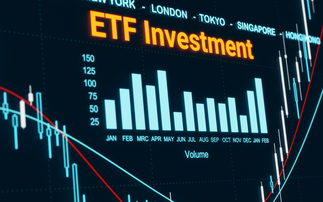INDUSTRY VOICE: Lyxor's Cross Asset team looks at the economic backdrop for US assets - can the market hold up under recent strains?
US economic growth still looks firm - consumption remains the strongest driver, backed by continued consumer optimism and substantial wage gains. The current expansionary phase should soon become the joint second-longest in the country's history. Should it endure to next spring, it would be the longest ever. However, it could be showing signs of wear and tear.
Inflation is on the rise, so real consumption is outstripping income. The household savings rate has halved over the last couple of years, while rising delinquency rates for auto loans suggest early signs of consumer stress. Slower job growth and lower rates of savings means the recent tax cuts could be crucial - without them Trump's bid to sustain the current growth trend may be doomed to failure. The question is whether they have gone far enough.
Find out more about Europe's lowest cost US Equity ETF launched: 0.04% TER
Fiscal push or fiscal nudge?
Last December's tax reforms included a new corporate tax rate of 21%, the repeal of the corporate alternative minimum tax and full expensing of equipment for the next five years. The recent budget deal added further stimulus through federal spending. The amount likely to be injected into the US economy should exceed 1% of GDP each year. Yet, at this late stage of the cycle, the measures may not be entirely reflected in real activity. Overall, the fiscal push should add around 0.5% to growth this year - meaning a rate of around 2.75% by year end.
Whatever its real effects, it's still an unprecedentedly large stimulus package at such a late stage of the cycle and it will, in our view, undoubtedly spur on inflation in all its forms. A tight labour market should push wage inflation past the 3% mark within months. This would eventually pass through inflation prints and benefit US breakevens.
The fear of four
The exceptional conditions that have artificially suppressed yields since the Global Financial Crisis should continue to fade. We've long expected at least three hikes from the Fed in 2018, and now believe the possibility of four 25 basis point hikes is greater. Tighter policy normalisation cannot be ruled out. We suspect ten-year Treasury yields will push some way past 3%, so we are underweight over the long term. Shorter-term however, they retain their safe haven appeal should risk aversion spike.
How far from here?
The firmer wage growth at this late stage of the expansion is likely to dent corporate profitability. Margins could compress by about 0.5% per year, although the positive effects of tax reform will help to mitigate this to some degree. All told we expect solid earnings-per-share growth of around 9% this year but rather more sedate results next year as the cycle totters into its dotage. There may therefore only be limited upside for the mainstream indices like the S&P 500 Index from here - only products offering the lowest cost access, or the very best performance merit consideration.
Trading insults, rather than ideas
Greater consumer spending may encourage more imports as the US is hitting its capacity constraints. Any widening of the trade deficit could add further political pressure to Trump's tightwire trade agenda. The heady rhetoric and recent bout of brinkmanship seem more of negotiating tactic than they are a declaration of trade war or a U-turn on globalisation, not least because of looming mid-term elections. In our view, Trump won't risk blowing up a bull market - one of few feelgood factors at his disposal - at such a time.
View Lyxor's US Equity ETF range
Q2 positioning
So we still expect US equities to outperform bonds in Q2, albeit by a lesser margin than before. That said, the President's taste for battle may rattle some of the country's more risk-averse trading partners. Expect outward-looking international firms to suffer more than their domestic-focused counterparts. As a result, we're neutral on the outlook for the broader indices and our preference for selected themes, like favouring growth over value, and sectors.
Take capex for example; tax reform should help accelerate spending on non-residential investments and in technology, a sector representing 30% of current capex and around 35% of the S&P 500 Growth Index. Despite all the talk of a new tech bubble, valuations look merely stretched in places rather than speculative or bubbly.
Our one value-based call remains banks because of the sector's cyclicality. Commercial and industrial loans look likely to rebound, which will boost profitability. Higher inflation expectations also tend to translate into better prospects. The Fed's continued willingness to simplify regulation is the last of a powerful trio of clearly positive catalysts.
S&P 500 margins look vulnerable as the cycle matures
Source: Bloomberg, Macrobond, Lyxor AM
S&P500 Growth versus Value
Source: Bloomberg, Macrobond, Lyxor AM
In fixed income, away from our views on breakevens and treasuries, we've yet to really touch on credit. In our view, the picture is fairly bleak - especially for high yield because valuations appear high and the sector appears to be pricing in a growth rate far in excess of what's likely to eventuate in 2018.
Why choose Lyxor for US assets?
Whatever you're seeking to do in your US-related portfolio, we believe we can help. We offer 15+ routes to the market including Europe's lowest-cost Core US equity ETF at just 0.04%, as well as the best-performing S&P 500 ETF your money can buy. So if the upside is limited, you get to make the most of the opportunity. You can also generate income with the cheapest quality income ETF on the European market or take out some insurance against the possibility of renewed volatility with our minimum variance product - the most diverse of its kind.
We're not just equity experts though. We also offer the cheapest US Treasuries, US corporate bond and US HY bond ETFs on the market - among them some of the best-performing and most efficient you'll find. You'll also be able to adjust to the changing inflation picture with our US TIPS ETF and our unique US inflation expectations product.*
Find out more about Lyxor's Core ETF range
THIS COMMUNICATION IS FOR ELIGIBLE COUNTERPARTIES OR PROFESSIONAL CLIENTS ONLY
All data & opinion: Lyxor Cross Asset Research & Equity ETF teams, as at 11 April 2018 unless otherwise stated. Past performance is no guarantee of future returns. * All product data as at 31 January 2018 unless otherwise stated. All efficiency data is based on the efficiency indicator created by Lyxor's ETF Research department in 2013. It examines 3 components of performance: tracking error, liquidity and spread purchase/sale. Each peer group includes the relevant Lyxor ETF share-class and the 4 largest ETF share-classes issued by other providers, representing market-share of at least 5% on the relative index. ETF sizes are considered as an average of AUM levels observed over the relevant time period. Detailed methodology may be found in the paper ‘Measuring Performance of Exchange Traded Funds' by Marlène Hassine and Thierry Roncalli. Statements refer to European ETF market.
This document is for the exclusive use of investors acting on their own account and categorized either as "Eligible Counterparties" or "Professional Clients" within the meaning of Markets in Financial Instruments Directive 2004/39/EC. These products comply with the UCITS Directive (2009/65/EC). Société Générale and Lyxor International Asset Management (LIAM) recommend that investors read carefully the "investment risks" section of the product's documentation (prospectus and KIID). The prospectus and KIID are available free of charge on www.lyxoretf.com, and upon request to [email protected].
The products mentioned are the object of market-making contracts, the purpose of which is to ensure the liquidity of the products on the London Stock Exchange, assuming normal market conditions and normally functioning computer systems. Units of a specific UCITS ETF managed by an asset manager and purchased on the secondary market cannot usually be sold directly back to the asset manager itself. Investors must buy and sell units on a secondary market with the assistance of an intermediary (e.g. a stockbroker) and may incur fees for doing so. In addition, investors may pay more than the current net asset value when buying units and may receive less than the current net asset value when selling them. Updated composition of the product's investment portfolio is available on www.lyxoretf.com. In addition, the indicative net asset value is published on the Reuters and Bloomberg pages of the product, and might also be mentioned on the websites of the stock exchanges where the product is listed.
Prior to investing in the product, investors should seek independent financial, tax, accounting and legal advice. It is each investor's responsibility to ascertain that it is authorised to subscribe, or invest into this product. This document is of a commercial nature and not of a regulatory nature. This material is of a commercial nature and not a regulatory nature. This document does not constitute an offer, or an invitation to make an offer, from Société Générale, Lyxor Asset Management (together with its affiliates, Lyxor AM) or any of their respective subsidiaries to purchase or sell the product referred to herein.
Lyxor International Asset Management (LIAM), société par actions simplifiée having its registered office at Tours Société Générale, 17 cours Valmy, 92800 Puteaux (France), 418 862 215 RCS Nanterre, is authorized and regulated by the Autorité des Marchés Financiers (AMF) under the UCITS Directive (2009/65/EU) and the AIFM Directive (2011/31/EU). LIAM is represented in the UK by Lyxor Asset Management UK LLP, which is authorized and regulated by the Financial Conduct Authority in the UK under Registration Number 435658. Société Générale is a French credit institution (bank) authorised by the Autorité de contrôle prudentiel et de résolution (the French Prudential Control Authority).
Lyxor International Asset Management ("LIAM") or its employees may have or maintain business relationships with companies covered in its research reports. As a result, investors should be aware that LIAM and its employees may have a conflict of interest that could affect the objectivity of this report. Investors should consider this report as only a single factor in making their investment decision. Please see appendix at the end of this report for the analyst(s) certification(s), important disclosures and disclaimers. Alternatively, visit our global research disclosure website www.lyxoretf.com/compliance.













